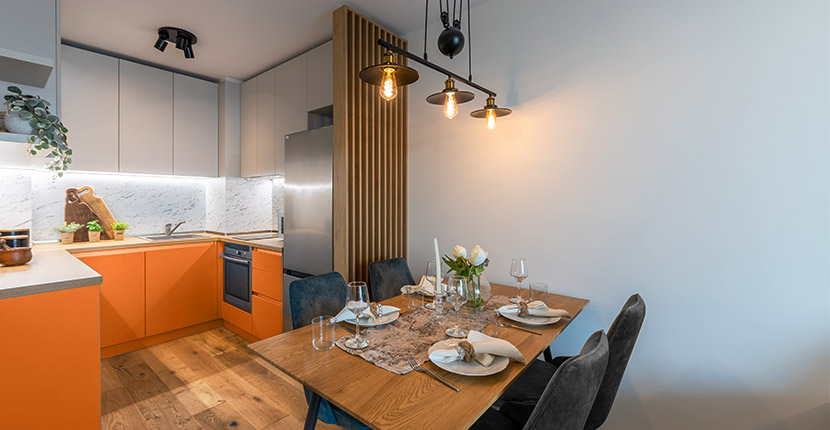What Kind of Lighting is Best for a Kitchen?
- by Bryan Veldboom - updated on 5/12/2022

Selecting the right lighting for a home kitchen can be a daunting task. With all of the bulbs and fixtures to choose from—not to mention measurements like color temperature and brightness—it's easy to get overwhelmed. If you've been struggling to tell a lumen from a Kelvin, our kitchen lighting guide is just what you need. Keep reading for some simple tips to help you light your kitchen properly.
What are Kelvins and Lumens?
Before we get into specifics, let's define a couple of key terms first.
Kelvins
- Measures color temperature, or how closely the light given off by a bulb resembles actual daylight
- Light with a lower number of Kelvins is warmer and more yellowish in color and is best suited for reading and other relaxing tasks
- High Kelvin lighting gives off a cooler bright white or bluish white light that helps keep you more alert and focused, making it well-suited for workspaces and other "active" areas
Lumens
- Measures a light bulb's brightness
- A higher number of lumens equals a brighter bulb
Should Kitchen Lights Be Warm or Cool?
When lighting your kitchen, it's actually a good idea to use lights with a variety of different color temperatures throughout the room. For overhead accent lighting, we suggest using a warmer bulb in the range of 2,700 to 3,000 Kelvins. This will help you match the color temperature of your other rooms, creating a consistent feel to your overall lighting scheme.
For task lighting though, you'll definitely want something that's higher on the Kelvin scale. If you have track lighting or under cabinet lights, use bulbs in the 4,000 - 5,000 Kelvin range. Higher Kelvin light more closely resembles daylight, making it ideal for cooking and meal prep tasks.
How Bright Should Kitchen Lights Be?
Just like with color temperature, it's a good idea to use a mixture of light bulbs with varying levels of brightness throughout the room. For accent lighting, shoot for something between 200 and 300 lumens. Ambient lighting is used to add atmosphere to the room, so you can get away with a more subtle 50 lumen light bulb.
For areas where you plan on preparing food, you'll want lighting that's much brighter. Bulbs with a brightness of around 500 lumens will provide you with enough light to safely handle knives and perform other delicate cooking tasks. You'll also want a brighter bulb for lighting pantries or other storage areas.
What are the Best Light Bulbs for a Kitchen?
As a consumer, you have several different light bulb types available to you, including incandescents, fluorescents, CFLs, halogens and LEDs. All of these bulb types are available in a variety of color temperatures and brightness levels, so that shouldn't have an impact on which type you choose. The biggest differences between them are cost, energy efficiency and lifespan. You can find a breakdown of their average lifespans in our blog entitled "What Kind of Light Bulb Lasts the Longest?"
There are a few basic things though you should keep in mind. Halogen bulbs give off incredible amounts of heat, so you probably want to avoid using them for counter or under cabinet lighting. LEDs are the longest-lasting and most energy-efficient bulbs, however, some LED bulbs can't be used in enclosed fixtures. When determining if an LED bulb is compatible with an enclosed fixture, check the packaging. The manufacturer will typically list whether or not the bulb is rated for enclosed fixtures.
What are the Best Lighting Fixtures for a Kitchen?
The type of fixtures you choose will be based on the size of your kitchen as well as your personal sense of style. In general, however, here are some basic suggestions.
- Ambient lighting: downlights
- Task lighting: under cabinet fixtures, LED linear tubes, LED puck lights or LED strip lights
- Cabinet lighting: cove lights
- Kitchen islands: pendant lights
Batteries Plus is Your Lighting Headquarters
Batteries Plus sells an enormous selection of light bulbs, fixtures and ballasts for your home, vehicle or business needs. If you're interested in automating your home lighting, be sure to check out our selection of smart light bulbs too. You'll also find plenty of additional information in our Lighting Purchasing Guide and online blog. A few of our most popular blog articles include "How to Accent Your Yard or Patio with New Solar Lighting" and "5 Types of Indoor Lighting Fixtures at Batteries Plus."